Identification of New Mycobacterium tuberculosis Proteasome Inhibitors Using a Knowledge-Based Computational Screening Approach
Abstract
1. Introduction
2. Methodology
2.1. Protein Structure Preparation
2.2. Database Collection and Refinement
2.3. Receptor-Based Virtual Screening
2.4. Molecular Docking
2.5. LIGPLOT+ Analysis
2.6. Drug-Likeness
2.7. Molecular Dynamics (MD) Simulations
3. Results and Discussion
3.1. Virtual Screening, Molecular Docking, and LIGPLOT
3.2. MD Simulation
3.2.1. RMSD
3.2.2. RMSF
3.2.3. Radius of Gyration (Rg)
3.2.4. Minimum Distance
3.2.5. Number of Hydrogen Bonds (H-Bond Number)
4. Conclusions
Author Contributions
Funding
Institutional Review Board Statement
Informed Consent Statement
Data Availability Statement
Conflicts of Interest
Sample Availability
References
- MacNeil, A.; Glaziou, P.; Sismanidis, C.; Maloney, S.; Floyd, K. Global Epidemiology of Tuberculosis and Progress Toward Achieving Global Targets—2017. MMWR Morb. Mortal. Wkly. Rep. 2019, 68, 263–266. [Google Scholar] [CrossRef]
- Bloom, B.R.; Atun, R.; Cohen, T.; Dye, C.; Fraser, H.; Gomez, G.B.; Knight, G.; Murray, M.; Nardell, E.; Rubin, E.; et al. Tuberculosis. In Major Infectious Diseases, 3rd ed.; Holmes, K.K., Bertozzi, S., Bloom, B.R., Jha, P., Eds.; The International Bank for Reconstruction and Development/The World Bank: Washington, DC, USA, 2017. [Google Scholar] [CrossRef]
- Raviglione, M.C.; Smith, I.M. XDR tuberculosis—Implications for global public health. N. Engl. J. Med. 2007, 356, 656–659. [Google Scholar] [CrossRef]
- Saxena, A.K.; Singh, A. Mycobacterial tuberculosis Enzyme Targets and their Inhibitors. Curr. Top Med. Chem. 2019, 19, 337–355. [Google Scholar] [CrossRef] [PubMed]
- Bibo-Verdugo, B.; Jiang, Z.; Caffrey, C.R.; O’Donoghue, A.J. Targeting proteasomes in infectious organisms to combat disease. FEBS J. 2017, 284, 1503–1517. [Google Scholar] [CrossRef] [PubMed]
- Darwin, K.H.; Ehrt, S.; Gutierrez-Ramos, J.C.; Weich, N.; Nathan, C.F. The proteasome of Mycobacterium tuberculosis is required for resistance to nitric oxide. Science 2003, 302, 1963–1966. [Google Scholar] [CrossRef] [PubMed]
- Gandotra, S.; Schnappinger, D.; Monteleone, M.; Hillen, W.; Ehrt, S. In vivo gene silencing identifies the Mycobacterium tuberculosis proteasome as essential for the bacteria to persist in mice. Nat. Med. 2007, 13, 1515–1520. [Google Scholar] [CrossRef] [PubMed]
- Zhai, W.; Wu, F.; Zhang, Y.; Fu, Y.; Liu, Z. The Immune Escape Mechanisms of Mycobacterium Tuberculosis. Int. J. Mol. Sci. 2019, 20, 340. [Google Scholar] [CrossRef]
- Hu, G.; Lin, G.; Wang, M.; Dick, L.; Xu, R.M.; Nathan, C.; Li, H. Structure of the Mycobacterium tuberculosis proteasome and mechanism of inhibition by a peptidyl boronate. Mol. Microbiol. 2006, 59, 1417–1428. [Google Scholar] [CrossRef]
- Groll, M.; Ditzel, L.; Lowe, J.; Stock, D.; Bochtler, M.; Bartunik, H.D.; Huber, R. Structure of 20S proteasome from yeast at 2.4 A resolution. Nature 1997, 386, 463–471. [Google Scholar] [CrossRef]
- Kwon, Y.D.; Nagy, I.; Adams, P.D.; Baumeister, W.; Jap, B.K. Crystal structures of the Rhodococcus proteasome with and without its pro-peptides: Implications for the role of the pro-peptide in proteasome assembly. J. Mol. Biol. 2004, 335, 233–245. [Google Scholar] [CrossRef]
- Lin, G.; Li, D.; Chidawanyika, T.; Nathan, C.; Li, H. Fellutamide B is a potent inhibitor of the Mycobacterium tuberculosis proteasome. Arch. Biochem. Biophys. 2010, 501, 214–220. [Google Scholar] [CrossRef] [PubMed]
- Lin, G.; Li, D.; de Carvalho, L.P.; Deng, H.; Tao, H.; Vogt, G.; Wu, K.; Schneider, J.; Chidawanyika, T.; Warren, J.D.; et al. Inhibitors selective for mycobacterial versus human proteasomes. Nature 2009, 461, 621–626. [Google Scholar] [CrossRef] [PubMed]
- Rozman, K.; Alexander, E.M.; Ogorevc, E.; Bozovicar, K.; Sosic, I.; Aldrich, C.C.; Gobec, S. Psoralen Derivatives as Inhibitors of Mycobacterium tuberculosis Proteasome. Molecules 2020, 25, 1305. [Google Scholar] [CrossRef] [PubMed]
- Zheng, Y.; Jiang, X.; Gao, F.; Song, J.; Sun, J.; Wang, L.; Sun, X.; Lu, Z.; Zhang, H. Identification of plant-derived natural products as potential inhibitors of the Mycobacterium tuberculosis proteasome. BMC Complement Altern. Med. 2014, 14, 400. [Google Scholar] [CrossRef] [PubMed]
- Lin, G.; Tsu, C.; Dick, L.; Zhou, X.K.; Nathan, C. Distinct specificities of Mycobacterium tuberculosis and mammalian proteasomes for N-acetyl tripeptide substrates. J. Biol. Chem. 2008, 283, 34423–34431. [Google Scholar] [CrossRef] [PubMed]
- Pinzi, L.; Rastelli, G. Molecular Docking: Shifting Paradigms in Drug Discovery. Int. J. Mol. Sci. 2019, 20, 4331. [Google Scholar] [CrossRef]
- Ivanova, L.; Karelson, M.; Dobchev, D.A. Multitarget Approach to Drug Candidates against Alzheimer’s Disease Related to AChE, SERT, BACE1 and GSK3beta Protein Targets. Molecules 2020, 25, 1846. [Google Scholar] [CrossRef]
- Sethi, A.; Joshi, K.; Sasikala, K.; Alvala, M. Molecular docking in modern drug discovery: Principles and recent applications. In Drug Discovery and Development—New Advances; IntechOpen : London, UK, 2019; pp. 27–39. [Google Scholar] [CrossRef]
- Langdon, S.R.; Westwood, I.M.; van Montfort, R.L.; Brown, N.; Blagg, J. Scaffold-focused virtual screening: Prospective application to the discovery of TTK inhibitors. J. Chem. Inf. Model. 2013, 53, 1100–1112. [Google Scholar] [CrossRef]
- Yang, S.C.; Chang, S.S.; Chen, H.Y.; Chen, C.Y. Identification of potent EGFR inhibitors from TCM Database@Taiwan. PLoS Comput. Biol. 2011, 7, e1002189. [Google Scholar] [CrossRef]
- Valasani, K.R.; Vangavaragu, J.R.; Day, V.W.; Yan, S.S. Structure based design, synthesis, pharmacophore modeling, virtual screening, and molecular docking studies for identification of novel cyclophilin D inhibitors. J. Chem. Inf. Model. 2014, 54, 902–912. [Google Scholar] [CrossRef]
- Morris, G.M.; Huey, R.; Lindstrom, W.; Sanner, M.F.; Belew, R.K.; Goodsell, D.S.; Olson, A.J. AutoDock4 and AutoDockTools4: Automated docking with selective receptor flexibility. J. Comput. Chem. 2009, 30, 2785–2791. [Google Scholar] [CrossRef]
- Daina, A.; Michielin, O.; Zoete, V. SwissADME: A free web tool to evaluate pharmacokinetics, drug-likeness and medicinal chemistry friendliness of small molecules. Sci. Rep. 2017, 7, 42717. [Google Scholar] [CrossRef] [PubMed]
- Pires, D.E.; Blundell, T.L.; Ascher, D.B. pkCSM: Predicting Small-Molecule Pharmacokinetic and Toxicity Properties Using Graph-Based Signatures. J. Med. Chem. 2015, 58, 4066–4072. [Google Scholar] [CrossRef] [PubMed]
- MacKerell, A.D., Jr. Atomistic models and force fields. Comput. Biochem. Biophys. 2001, 9, 7–38. [Google Scholar]
- Tyagi, R.; Srivastava, M.; Jain, P.; Pandey, R.P.; Asthana, S.; Kumar, D.; Raj, V.S. Development of potential proteasome inhibitors against Mycobacterium tuberculosis. J. Biomol. Struct. Dyn. 2020, 19, 1–15. [Google Scholar] [CrossRef] [PubMed]
- Mehra, R.; Chib, R.; Munagala, G.; Yempalla, K.R.; Khan, I.A.; Singh, P.P.; Khan, F.G.; Nargotra, A. Discovery of new Mycobacterium tuberculosis proteasome inhibitors using a knowledge-based computational screening approach. Mol. Divers. 2015, 19, 1003–1019. [Google Scholar] [CrossRef]
- Shaikh, S.; Zainab, T.; Shakil, S.; Rizvi, S.M. A neuroinformatics study to compare inhibition efficiency of three natural ligands (Fawcettimine, Cernuine and Lycodine) against human brain acetylcholinesterase. Network 2015, 26, 25–34. [Google Scholar] [CrossRef] [PubMed]
- Rizvi, S.M.; Shaikh, S.; Khan, M.; Biswas, D.; Hameed, N.; Shakil, S. Fetzima (levomilnacipran), a drug for major depressive disorder as a dual inhibitor for human serotonin transporters and beta-site amyloid precursor protein cleaving enzyme-1. CNS Neurol. Disord. Drug Targets 2014, 13, 1427–1431. [Google Scholar] [CrossRef] [PubMed]
- Copeland, R.A. Conformational adaptation in drug-target interactions and residence time. Future Med. Chem. 2011, 3, 1491–1501. [Google Scholar] [CrossRef] [PubMed]

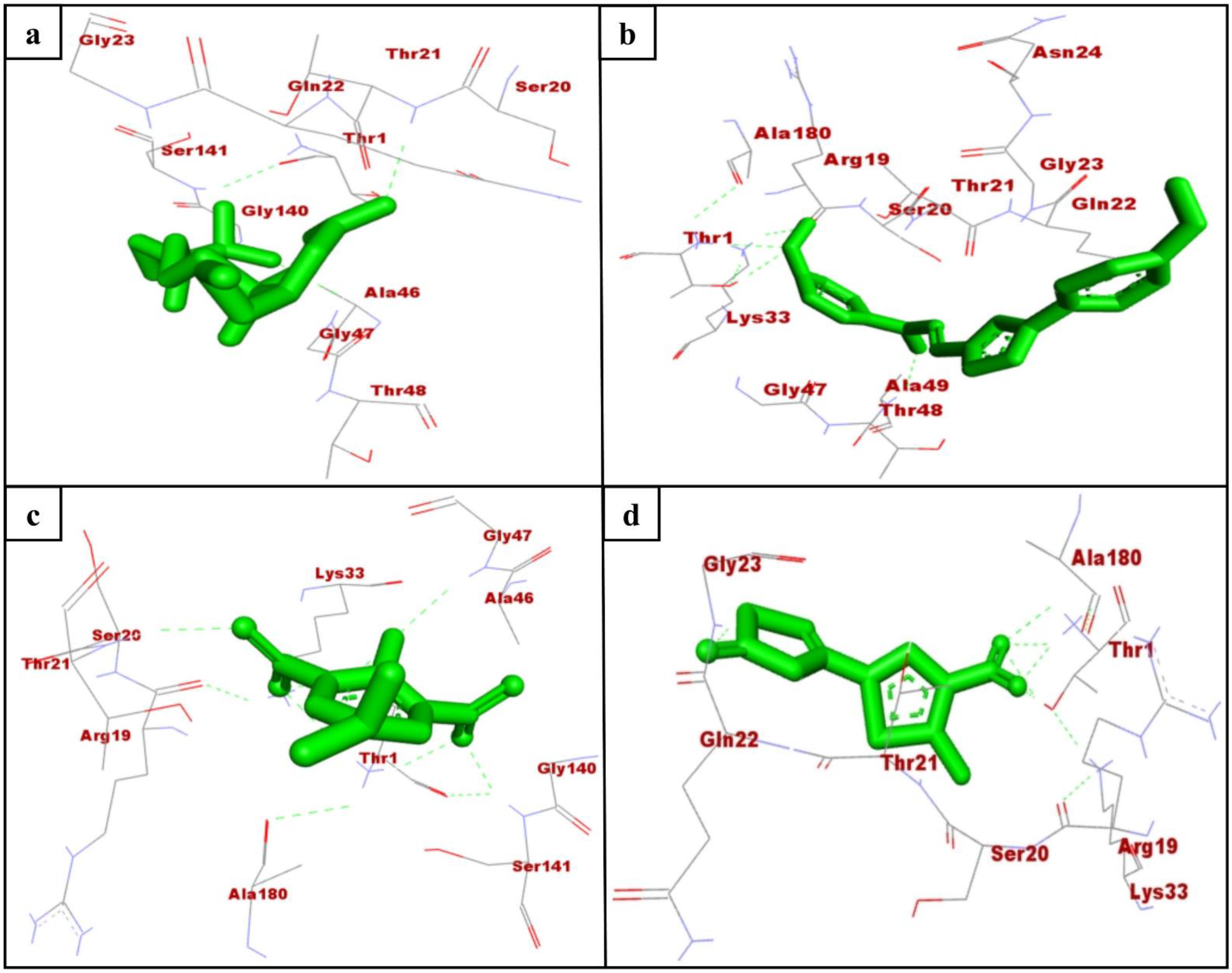

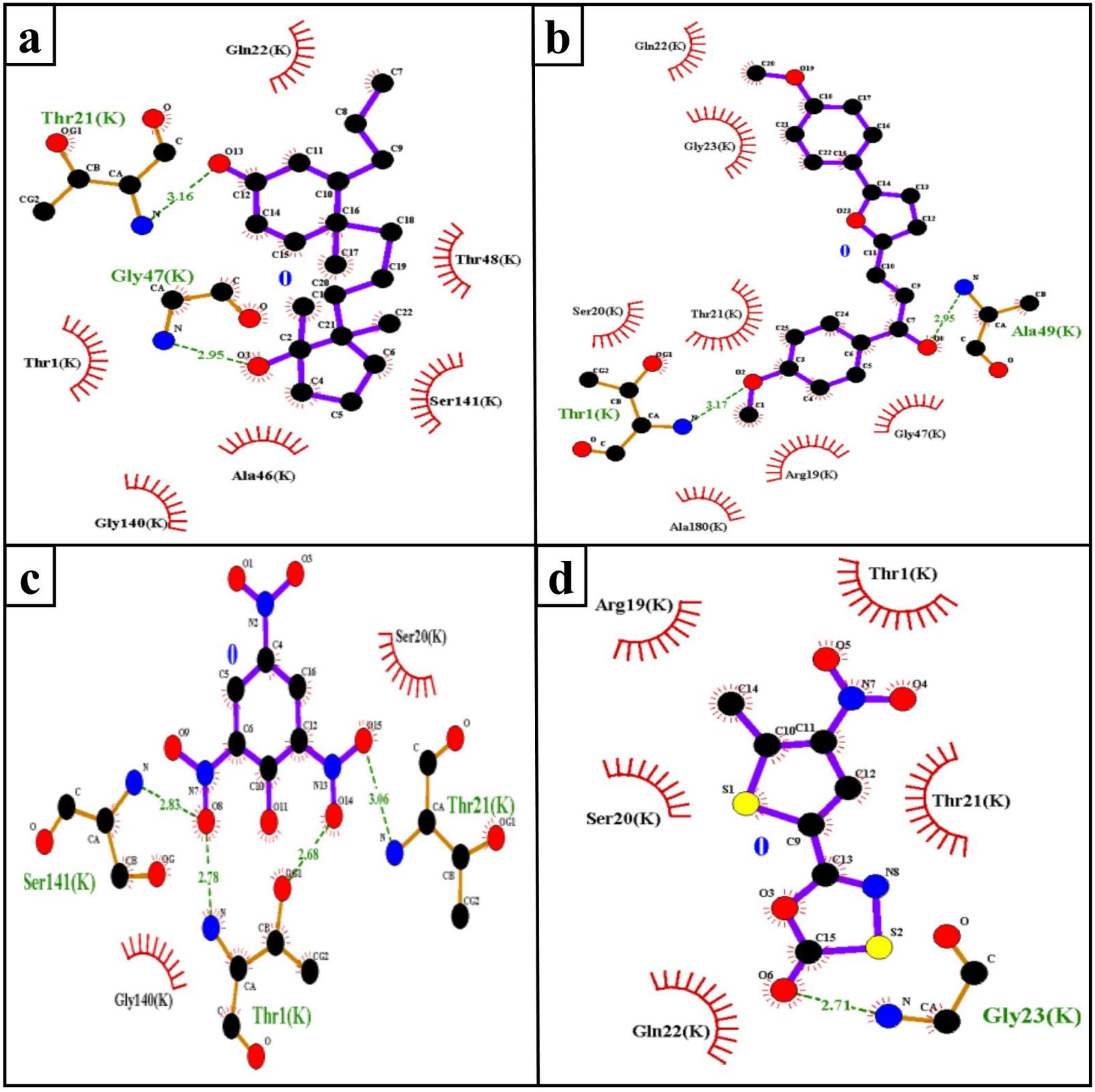
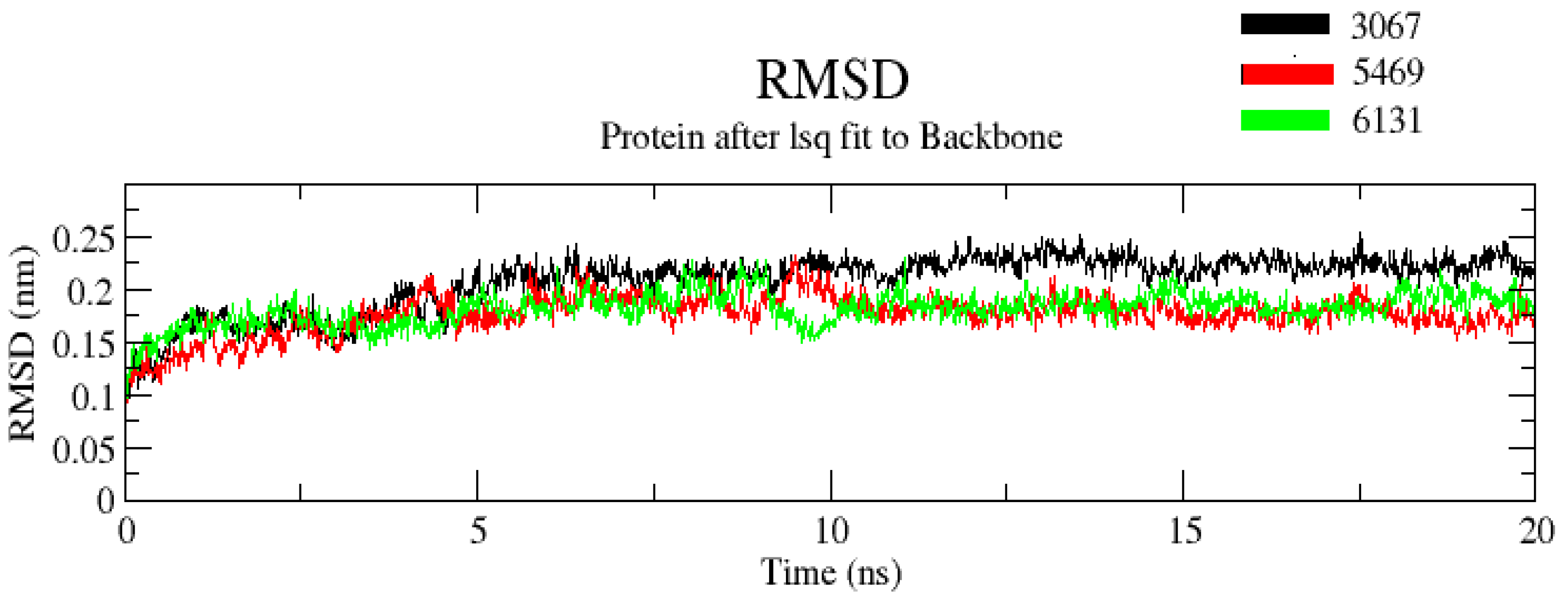
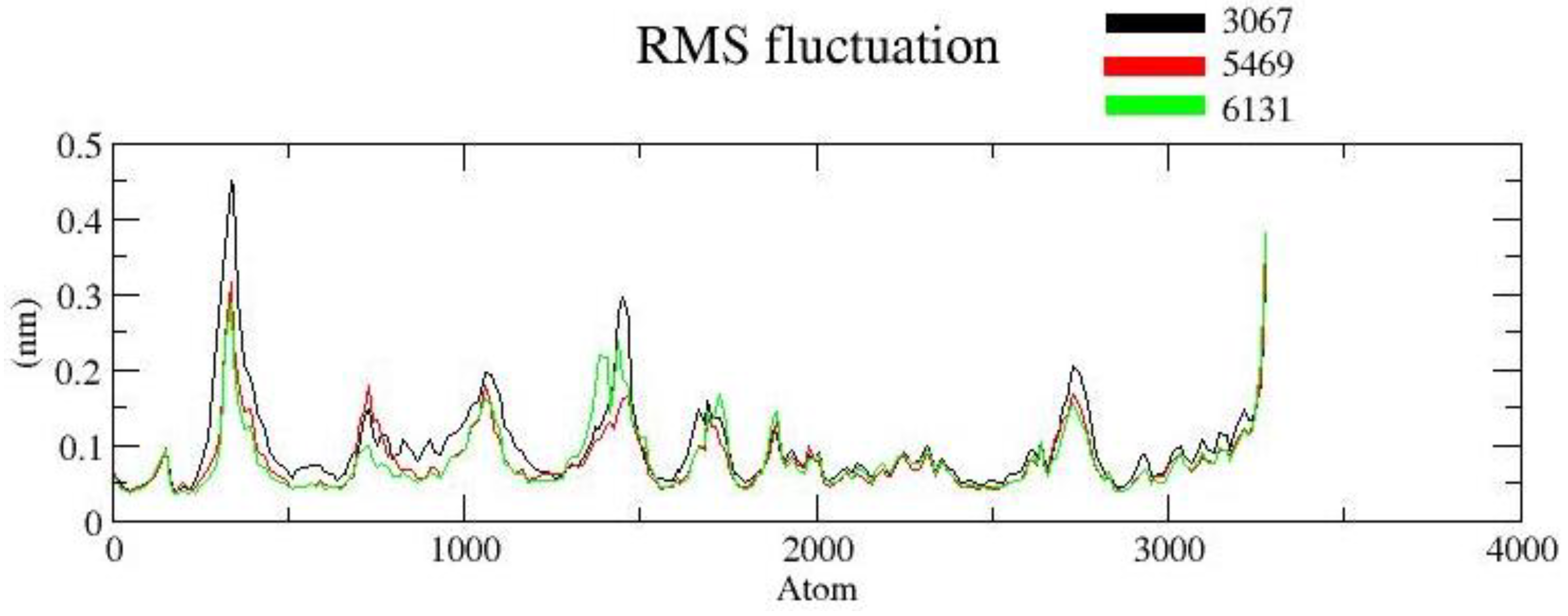
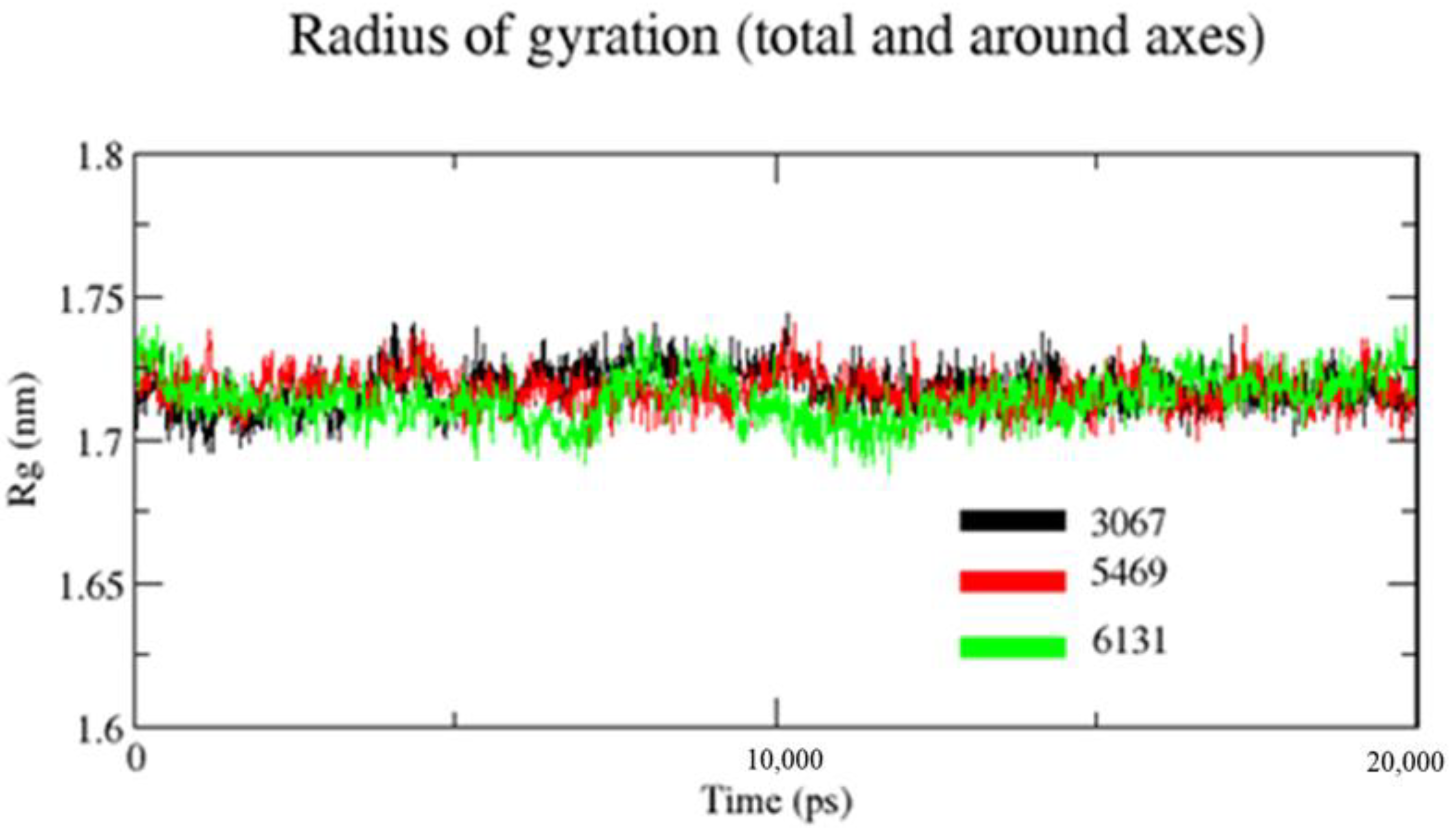

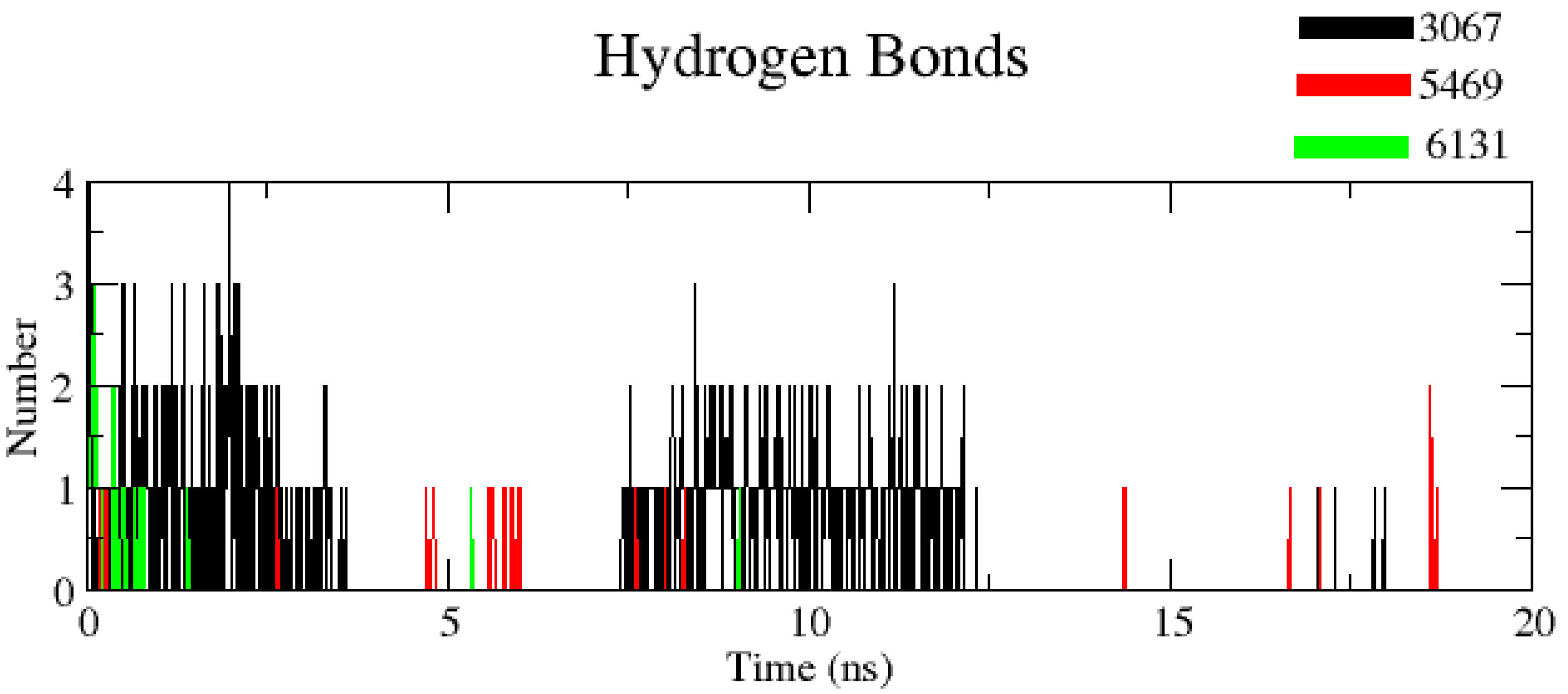
| Compound | Binding Energy (kcal/mol) | Inhibition Constant (µM) | ||
|---|---|---|---|---|
| Monomer | Dimer | Monomer | Dimer | |
| ZINC3875469 | −7.19 | −8.05 | 28.9 | 26.54 |
| ZINC4076131 | −7.95 | −9.10 | 43.24 | 0.213 |
| ZINC1883067 | −7.21 | −7.07 | 27.92 | 23.96 |
| HT1171 * | −5.83 | −5.97 | 45.36 | 47.01 |
| S.No. | Target | Compound | H-Bond | H-Bond Length (Å) |
|---|---|---|---|---|
| 1. | Mtb proteasome | ZINC1883067 | THR1:HN3-UNK0:O8 | 2.78 |
| THR1:HG1-UNK0:O14 | 2.68 | |||
| THR21:HN-UNK0:O15 | 3.06 | |||
| SER141:HN-UNK0:O8 | 2.83 | |||
| 2. | ZINC4076131 | THR1:HT3-UNK0:O2 | 3.17 | |
| ALA49:HN-UNK0:O8 | 2.95 | |||
| 3. | ZINC3875469 | THR21:HN-UNK0:O13 | 2.15 | |
| GLY47:HN-UNK0:O3 | 2.49 | |||
| 4. | HT1171 | GLY23:HN-UNK0:O6 | 2.71 |
| Property | Model Name | Predicted Value | Unit | |||
|---|---|---|---|---|---|---|
| ZINC1883067 | ZINC4076131 | ZINC3875469 | ||||
| Absorption | Water solubility | −3.67 | −5.213 | −4.624 | log mol/L | |
| Caco2 permeability | −0.275 | 1.432 | 1.569 | log Papp in 10–6 cm/s | ||
| Intestinal absorption (human) | 81.583 | 97.413 | 96.726 | % Absorbed | ||
| Skin Permeability | −2.786 | −2.629 | −2.985 | log Kp | ||
| Distribution | VDss (human) | −0.44 | 0.315 | 0.397 | log L/kg | |
| Fraction unbound (human) | 0.173 | 0.118 | 0.105 | Fu | ||
| BBB permeability | −1.036 | 0.099 | 0.2 | log BB | ||
| CNS permeability | −2.744 | −1.483 | −2.42 | log PS | ||
| Metabolism | CYP2D6 substrate | No | No | No | Yes/No | |
| CYP3A4 substrate | No | Yes | Yes | |||
| inhibitor | CYP1A2 | Yes | Yes | No | ||
| CYP2C19 | No | Yes | No | |||
| CYP2C9 | No | Yes | No | |||
| CYP2D6 | No | No | No | |||
| CYP3A4 | No | No | No | |||
| Excretion | Total Clearance | 0.587 | 0.742 | 0.636 | log mL/min/kg | |
| Renal OCT2 substrate | No | No | Yes | Yes/No | ||
| Toxicity | AMES toxicity | Yes | No | No | ||
| Max. tolerated dose (human) | −0.58 | 0.547 | −0.423 | log mg/kg/day | ||
| hERG I inhibitor | No | No | No | Yes/No | ||
| Oral Rat Acute Toxicity (LD50) | 2.321 | 2.347 | 1.837 | mol/kg | ||
| Oral Rat Chronic Toxicity (LOAEL) | 1.35 | 1.913 | 1.708 | log mg/kg_bw/day | ||
| Hepatotoxicity | No | No | No | Yes/No | ||
| Skin Sensitisation | Yes | No | No | |||
| T. pyriformis toxicity | 0.804 | 0.569 | 1.054 | (log μg/L) | ||
| Minnow toxicity | 0.644 | −2.307 | 0.712 | |||
| Druglikeness | Lipinski | Yes | Yes | Yes | (Yes/No) | |
Publisher’s Note: MDPI stays neutral with regard to jurisdictional claims in published maps and institutional affiliations. |
© 2021 by the authors. Licensee MDPI, Basel, Switzerland. This article is an open access article distributed under the terms and conditions of the Creative Commons Attribution (CC BY) license (https://creativecommons.org/licenses/by/4.0/).
Share and Cite
Almeleebia, T.M.; Shahrani, M.A.; Alshahrani, M.Y.; Ahmad, I.; Alkahtani, A.M.; Alam, M.J.; Kausar, M.A.; Saeed, A.; Saeed, M.; Iram, S. Identification of New Mycobacterium tuberculosis Proteasome Inhibitors Using a Knowledge-Based Computational Screening Approach. Molecules 2021, 26, 2326. https://doi.org/10.3390/molecules26082326
Almeleebia TM, Shahrani MA, Alshahrani MY, Ahmad I, Alkahtani AM, Alam MJ, Kausar MA, Saeed A, Saeed M, Iram S. Identification of New Mycobacterium tuberculosis Proteasome Inhibitors Using a Knowledge-Based Computational Screening Approach. Molecules. 2021; 26(8):2326. https://doi.org/10.3390/molecules26082326
Chicago/Turabian StyleAlmeleebia, Tahani M., Mesfer Al Shahrani, Mohammad Y. Alshahrani, Irfan Ahmad, Abdullah M. Alkahtani, Md Jahoor Alam, Mohd Adnan Kausar, Amir Saeed, Mohd Saeed, and Sana Iram. 2021. "Identification of New Mycobacterium tuberculosis Proteasome Inhibitors Using a Knowledge-Based Computational Screening Approach" Molecules 26, no. 8: 2326. https://doi.org/10.3390/molecules26082326
APA StyleAlmeleebia, T. M., Shahrani, M. A., Alshahrani, M. Y., Ahmad, I., Alkahtani, A. M., Alam, M. J., Kausar, M. A., Saeed, A., Saeed, M., & Iram, S. (2021). Identification of New Mycobacterium tuberculosis Proteasome Inhibitors Using a Knowledge-Based Computational Screening Approach. Molecules, 26(8), 2326. https://doi.org/10.3390/molecules26082326








